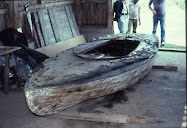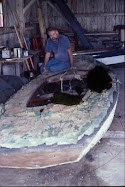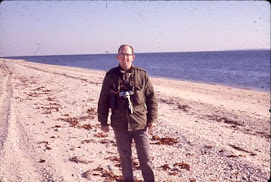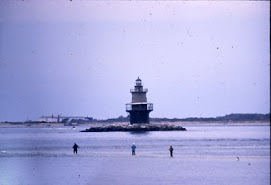Some times when I am writing a story another more inter interesting story comes to mind, so I drop the one I was working on. So I dropped the next story I was working on and started this story.
Who would understand the characters of that time would have to have there. This takes place in about 1940. The place was in Greenport LI, NY and the house was our house on Manor Place (across the street from ELIH). The house is no longer there it and 4 others were plowed down for a parking lot 40 years ago. This house has its own story mostly unbelievable but true. It appears in several other stories. Anyway, we had been living there for 2 years and had just got electricity upstairs. We had been living in the dark most of the time the only other lights was the light in the kitchen ceiling and two receptacles on the wall. We had an icebox when we moved in; it would be an antique even back then. We thought we really had it made getting a modern refrigerator that was probably 12 years old. It was one that had all the referent inside in most new refrigerators this was on the top so that it made the refrigerator nearly 7 foot high. This icebox didn’t have any ice in it just two little trays divided by 24 little blocks called cubes. I don’t know why they just didn’t call them ice blocks; I guess they wanted a place to use that word. The fridge was delivered by an old dump truck and it took 3 men to manhandle it up the cement steps. They plugged it in and the lights dimmed in the kitchen, and the light in the ceiling flickered for a while.
One of men said “the fridge takes a lot of juice but once the house gets used to it the light will not flicker.”
The fridge. ran for about an hour and turned off it was getting colder and got down to about 35 but didn’t make any ice yet. However when it turned on again it blew the fuse. When Dad got home he put in a new fuse in. and it blew again, and again. After 4 more trips upstairs to the fuse box Dad fixed it good by putting a penny in front of the fuse. At that time several houses in the area burned down I guess if our house burned down we would have a couple pennies. The fridge became useful after we got used to it.
After two weeks went by there was a strange smell in the kitchen and it was getting stronger.
Mom said “it was the fridge and the gas that made it get cold was leaking.”
It was getting stronger by the minute and we were getting sick from the smell. Mom ushered the four of us kids to her bedroom that was the furthest away from the kitchen.
My brother Alton said “he and my older sister Doris were going to go over to Hubbards' house” (about two houses west of our house.)
So, that left Nancy and me to die! We kept wet face cloths over our noses but that didn’t help. We hung our heads out any windows that we could open. Nancy and I went down stairs across the street to the hospital grounds; it seemed a little better over there. Meanwhile, 3 of our neighbors were trying to work the fridge out the door. One of them had a World War 1 gas mask, however, he couldn’t breath with it on. We thought we would cross the street to Capt Griffin’s house. His house was east of our house across Atlantic Ave..
By this time our neighbor Mr. Zipkas came over yelling, ”What are you try to kill my kids? What kind of gas you using to kill them? I was in the war, they had no gas that bad!”
Mr., Zipkas was recently returned from Europe, I guess he thought these men were up to no good. There were five men; two of them had brought a pick up truck. Now we were getting some! Not so…when three of them tried to go thru the door all three got stuck in their haste to get away from the kitchen. As it was two of them fell backward on to the porch, the third man fell over into the kitchen. They took another hour to extricate the regenerator from the floor. The floor was pretty rotten which didn’t help matters.
The truck was parked against the cement wall on our property, it stuck our almost all the way across the road. The truck plus all the junk they pulled off it to get the refridge. on the truck, had at least 4 cars blocked, two of which came over to see what was going on. It was a bad spot; there had been several accidents in that spot. Just as we were thinking about it a 32 Ford came barreling down the right side of the road, after rounding the corner, not realizing there was a lot more then a couple of cars blocking the road, (there were 4 on the left side, then the truck and three cars waiting on right side.) He slid past four cars but he couldn’t avoid the truck, he went as far to the right as possible. About in that spot was a Silver Maple Tree about 6 inches in diameter; he snapped the tree off about 4 feet from the ground. The tree became a many-branched bush in the coming years. The man driving the car only got a bloody nose as far as we could see. He left the car were it was blocking the road even further. The car and tree were both behind the truck when a few men (janitors from the hospital I thought) came over. What the hell is going on, by now there was about 15 people and 4 more cars, plus a hospital supply truck, a hearse and a big truck back about a block away. God this looks like Macys Parade! Who started this mess? The big truck didn’t have a muffler and it was issuing a cloud of smoke between the hospital and the row of houses.
“!!!!What the hell is there a fire someplace? Somebody exclaimed “Fire, fire I smell smoke! Must be a house down around this stupid corner. Why the hell didn’t somebody make these people on the corner cut that damn hedge down you cant see over it, you have to take a chance and take the corner blind.”
Nancy and I lived behind that hedge, which was the best part of our yard. A car accident once in
awhile cutting the hedge was the only thing Dad did outside. There was about 150 foot of hedge and Dad trimmed it faithfully.
We never thought of cutting it down the rest of the block had hedges on that side of the street.
One of the men coming from the hospital yelled fire, is any body hurt? Did anybody sound the alarm? There is a firebox right at the bottom of the hill that was at the exit of the hospital grounds.
Nancy and I always wondered what happened if you broke that glass and that little lever inside was pulled down, Well!! We were about to find out. At that time the fire boxes covered a certain area when the glass was broken a horn sounded. The horn was so loud it could be heard from Southhold to Orient. The fire boxes each had a code number for example our block number was 38 that met that pulling the handle the horn would automatically sound 3 short blasts and 8 long any ones over and over. That way the fireman could look at the fire chart and would know right away were the fire was. In this case there was no fire but it was too late. We told the man there was no fire (well Nancy did) I was afraid to say anything. The lady next door tried to get the fire dept. but think it was to late. A couple of men went past saying which house is it? I think it may be two houses. We know it’s not the hospital they have a special number.
I think one of the guys said “Maybe somebody didn’t know about the special number and it was really the hospital.”
“The fire is in the hospital! Oh No!” Said one of the men. “The fire is in the hospital! I told them that place is a fire hazard, now it will burn down for sure ,,,,,,,,,,,”
What about our fridge? They finally got the fridge on the truck and maneuvered the truck past the car and tree branches.
“I wonder where the fire is?” said the truck driver “Must be a fire somewhere, sure a lot of cars out here must be 35 cars. I think there must be a fire somewhere in town sure glad it’s down town or something there is sure traffic enough on this street.”
Meanwhile Nancy and I thought Mom might give us hell if we had not stayed upstairs. So we worked are way back through all those cars being held up by the fire. So we worked our way back up stairs just in time for Mom came looking for saying we were SOO GOOD to stay up there in the bedroom.
Meanwhile 2 fire trucks were trying to work there way past the row of cars blocking the street looking for our refrigerator fire.
Along the Susquehanna
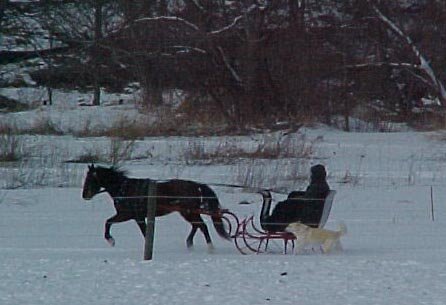
View from our front window
Thursday, January 06, 2011
Friday, July 16, 2010
Sterling Creek Chronicles

In the beginning God created heaven and earth however he left Sterling Creek to us. But, taking care of the creek at our ages was not in the cards. However, it was man’s job to change things and improve on it. Sterling Creek was first dredged in the early 1930’s. It was dredged to make a better channel for larger fishing boats. The creek did not have the brains to make itself deeper, we had to show nature how to handle it. It sometimes it takes years to find out how the creeks or wetlands withstood that major dredging. The mud was pumped onto several acres of land across from the hospital in Greenport. To hold the mud back, they built an 8 ft dike from the north side of the Catholic Cemetery about 800 ft in a loop back to the road to Gull Pond. The dikes were to hold back the mud from washing back into the creek. Several small spots were later dredged in the following years but they were not any major threat as was the original. However, by1960 the creek began a downward turn that it could not easily repair by its self and by 1965 the creek was slowly strangled by several smaller dredging, increased pollution, over fishing, and over crabbing was quickly over kill. Most creek users had no idea where these clam and shellfish come from it was some of those people who were robbing the creek of its life and didn’t realize it. We were able to see first hand how this worked. In a few more years Ray and I saw the creek get down to a low of 20—25 % of its former self. The creek that had supported 100’s of local people now was being a bulkhead for large cruisers both sides of the creek were being quickly used for boat storage and dock space.
We may have over stepped ourselves by self-proclaiming that we were the guardians of the creek but we never let that stop us. The fact that we were before our time never occurred to us. After all at that time we were 13 &15 years old. These next few quips (or observations) for examples of this.
Ray and I would cruse the creek usually after school or week ends. We would start at the north end of the creek and row our boat past he shipyards and check on boats pulled out of the water. Some of the boats were tied at both ends, it took more time to check these. This day in particular one of these boats was pulled up on the shore. This was probably the worse flagrant violation of the rights of the crabs that we had ever seen. (Crabs have rights) They probably had been fire lighting that night without exaggerating we counted 25 female crabs all with eggs. There was about 25 other crabs all of them had been out in the sun to long and were doomed. Ray and I threw all we could catch into the creek we felt bad about it and could see no excuse for this. This was about 1948-49 when we explored both sides of the crick. Ray and I knew every secret hiding place in the creek. There were deep holes in some parts of the creek and you would have to spend a good time finding them. People that crabbed the crick would leave crabs over night and throw them out the next day if they died, Blue crabs could survive out of the water up to two days if they were in the shade, or kept wet. It always surprised us how many illegal size crabs were left in the boats some times 25 or 30. Our family wasted little when it came to eating Blue crabs, Ray, his sister Meloney, my sister Nancy and I could sit on the dock and finish off a half bushel of crabs in one sitting. I think of all the seafood that came from the creek the Blue Crab was the top one with everybody. We had our share of hard clams and scallops after a few years of catching what ever came into the creek we started a little business of our own. We began having too many for ourselves so we had Rays grandfather build us 3 crab cars (his name for them) they were about 30 inches by 20 inches by 15 inches deep with a heavy screen on the bottom. They held about 15-20 crabs just the top was above the water we used one of the three for eels. We had a many as 20 eels in the box at one time. Pell’s fish market bought most of the eels they paid us $.45 a lb. for them cleaned. Pell’s sold them for $.85 that seemed a high price to us. Mostly Greeks who had summer places nearby enjoyed eels. Weak fish, blue fish and porgies sold for about $.30 a lb then. The blue crabs we kept in the crab cars were the ones we sold to Pell’s usually a dozen at a time. I think we got $1.50 a dozen I’m not sure how much the fish market charged for them probably double that. There were so many crabs on this end of the creek alone you really didn’t have to buy them. We were approached by several tourists asking how to catch them, naturally we never gave up our best tricks of catching crabs.
From the tourists at Capt. Griffin’s we sold 3 crabs for $1.00 each that was good money at that time. In those days late
1940’s, we were sort of an attraction for city dwellers. They thought we were sort of quaint. Ray and I would show off on more than one occasion. One day I was fishing for snappers (2 or 3 year old bluefish). I was fishing off the back of a boat tied off of Pell’s bulkhead. There were several tourists up on the bulkhead milling around. They noticed I was fishing with a 9 ft bamboo bob-pole.
“Someone,” asked, “what I was fishing for?
I said “snappers “
“What’s a snapper, how big are they?”
I told them ”Snappers are small blue fish 10 to 12 inches long. “
I had been keeping the snappers in a floating bait keeper, when I just was going to reach in and grab one, but the snapper grabbed my finger first and held on until they had a picture and someone said he got a photo of a Piranha off a dock in Greenport. At that same spot later there were about 7 or 8 tourists. Enjoying the ambiance of the time, when we herd a woman scream I could just see over the top of the bulkhead. One of the older ladies saw a couple of cute 1/4 grown crabs in the bottom of a pail and tried to pick one up and it grabbed her finger, I know how hard a crab can bite (pinch with claws). No body made any effort to help. In the meantime I had to climb up one of the piles to get to her before I got her she tried to pull it off and the crab grabbed the thumb of her other hand, he really had her. I think the woman’s screams were worse than any crab bite she must have sung in the Opera. I didn’t waste any time I just reached over and broke one of the claws off, I didn’t want to break them both off but as luck would have it the crab let go and ran off the dock.
At Ray Bishop’s house in 1938 and we became best friends. We spent the next 20 years on the creek. I believe we became icons of the creek. We new where the Blue Crabs were. We caught crabs by line or crab nets. Later we used crab traps. Fire lighting was a favorite way of crabbing (using a lantern at night) sometimes that didn’t seem fair. Mainly because they could not see you or the net, but it was a challenge to keep the crab in the lights you had to have complete control of the boat. Keeping the boat under control was sometimes harder then having the crab under control. There were bound to be some mishaps! Ray’s dad usually took us on our fire lighting outings. Ray and I kept the rowboat going in the direction that Dad yelled out …
“Go left Left, no Ray go back left no NO go strait oh S….T he crab went under the boat. Go left no NO three just stopped and buried themselves in the mud.”
He scooped his net into the mud and got only crick mud and seaweed. There’s just no way around it no matter how long your crab net may be. The biggest crabs are going to move just beyond the point you can reach. The crabs on your left in the shallow water head for the reeds. The crabs on your right will feel more secure if the was a little deeper. With crabs crisscrossing in every direction it was frustrating.
Ray’s mom made sure that Ray was taught how dangerous fire lighting can be. The equipment used was usually a 50-year-old kerosene lamp with a reflector on one side. They were mounted on the bow so as to cover the field of view. The older lamps always leaked. Some gas lamps were used. Ray’s father was more interested in explaining that with three people everybody must stay in his spot or the boat would flip. If the catcher reached to far to the left or to the right and you decided to move over to see what was going on that would make the boat lean causing the bow to lean “guess what!”
Of all the times we spent on or in the creek I think the crab lines we had set up along the creek was our most fun times. Our lines started at Ray’s Grandfathers boatyard and docks, across Pell’s bulkheads, Rays yard and then across to Captain Griffing’s property. We had 12 lines tied to the docks. It kept us busy. We usually used fish heads for bait and threw the lines out leaving slack in the lines, when a crab found the bait they would pull the line out to get it to deeper water. You could tell from a distance if a crab got on the line, they rarely would let go you just used your net and scooped them up sometimes 2 or 3 at once. There was never a shortage of fish heads from boats in the shipyard and Pell’s fish market. One of the regulars (City people) was named the DANDY and he always had something for us. Once he gave us a swordfish head they cut off and kept the rest to take back to the city You can’t imagine how the crabs went crazy over that swordfish head it probably weighed 20 lbs. It really was too big to use in your crab net and it was just about gone in 3 days.
The wrecks that were still in Sterling Creek, added to the ambiance of the creek. We were so used to seeing them, they were part of creek and could not be separated. The older ones had been there for 50 to 75 years and were firmly ensconced in permanent positions and were still recognized as barges. I’m not sure what they originally used for but they were built with heavy materials 10 by12 inch beams that it took a long time to rot. Boats of lesser materials would long since have disappear. Only one barge had a little life left in it to entertain us humans. I don’t know who owned it, the barge was hard to see as a barge as it was nearly square and what appeared to be a cabin added to the center. The barge actually was used by anyone that needed a place to clean fish clams, scallops etc. The cabin had door on it and on several occasions a band would practice there. There was a dock off sorts that led from the shore up to the barge. There was about a 6 to 8 ft walkway around the shack, that you could walk around or swim if you had no aversion to muddy water. At low tide the end of barge that stuck out in deep water was only 2 ft deep and at high tide the front of the barge was about 6 ft deep. I remember being over there at high tide and the water was 3 or 4 inches over the deck. This barge was only 4 houses north Bishop’s boatyard off a dead end road. I usually took the rowboat to get there.
There was one other barge we spent time on and that one was nearly across the creek from Pell’s. It stood a good 8 ft high about 40 by 50 ft long. It was like a mud city inside. The fiddlers had about 100 holes, there were rock crabs, lady crabs, periwinkles, and piss clams (clams that squirt a stream of water as much as 3 ft when you got near them) we also called them soft clams (upstate they call them little necks). Within a 250’ of the barge was the best area for soft clams, crabs, eels snappers, small weak fish, king fish, flounders and a plethora of young fingerlings of other fish some unidentified fish caught in our traps and released it always amazed us of how many different fish spawned in the creek and grew up in the safety of the creeks and found food aplenty. They stayed in the creek until they were big enough to fend for them selves in the bays and the sound. If you go claming for soft clams bring a fast shovel or better yet a fast dog that enjoys digging clams. Campbell’s dog Pal and Ray’s grandfathers dog Falco got a kick out of digging calms, actually we did not teach them to do that. I don’t think the people who kept their boats pulled up on shore liked that.
Through out the summer and fall when exploring the creeks in and out. The schools of bunkers some times were twice as long as our boat. For mutual protection they gather in schools sometimes in the 1000’s. They weave in and out the docks. If you are in the right spot you can see they will sometimes flash all at once turning from their dark side to there silver side, and that some what confuses the predators following them. When at times the bluefish come up to the top, the bunkers will jump. One of the best bunker times was down near the Booth House. Ray’s 2hp motor had conked out so we were just sitting there. Just inside the creek, a large school of bunkers maybe 20 ft long 10 or 15 ft wide just cleared the creek entrance, another school nearly as big had just passed us and was heading out of the creek. The school coming in was closer to the surface you could tell because of all the ripples. They looked like they were about to hit head on. They both scared each other, the school going out the entrance jumped first. There was probably 1000’that jumped maybe half the school nearly at the same time.
The wrecks of boats, most of them were rotted down to the low tide line, were not noticed by the casual observer. Trying to land on the opposite side of the creek with a motorboat at random you may hit part of a sunken wreck. There was a boat that had sunk on its side that was out in the middle of the creek about 200 ft from Bishops about 50 ft from the channel.
However, the most amazing wreck of all was a true story that Nancy and I found out about years later. For 3 years we would go across the street and play. We were on a big sailing ship. We spent quite a few days there doing some crabbing, caught minnows’, and white bait. We began to imagine we were world travelers. That this was a real ship didn’t sink in. In one end facing north about 15ft from Ray Bishop’s Land about 20 ft out in the water was a tall heavy sort of curved beam with other beams under the water. It stood a good 6 or 7 ft out of the water for a while there was a dock on part of it. At low tide you could get out to it. The top was a little too high to use a crab net. From here I used my imagination a little because both for and aft there was no way without something blocking the weather tides and waves and keeping a sheltered for plants to get started, I say this because plants would be protected by a ships bow and land on the leeward side. On this side of the creek all the way to the creeks inlet there were no cattails or marsh plants they had to have time to get started. In the middle of these plants was a metal life boat about 16 ft long one side under the mud. Going south the outside wall of the ship seemed easy to find except for the first 60 ft then it appears and for about 60 ft as a double wall hull that was above high tide only a few inches but it had 3 docks using the ship’s hull as a base. As rotten as the wood appeared it was still held it together. There were posts and spiles several. I remember Nancy showing me a round tank of sorts it had holes all around it and rock crabs had their homes in it. I had not put things together about the boat and the size and what was it until it must have been 1951 not sure of the year. However there was an antique house across from Porky’s Restaurant that someone bought. They wanted it moved to Orient but it had to go by boat (barge). I and about ten other kids followed it. The last day we followed them they turned down Manor Place actually my home street. It would take another 3 hours to make it to the pick up by the barge. I thought I would go down and check things. They had not gotten to the dock yet apparently there was to many telephone and electric poles. The guy on the barge put the cable on the first pole it came out easily as did the second did. The third one wanted to stay were it was. It was a big ship's rudder about 8 ft by10-ft was covered with 200 pounds of mud. WOW this was our rudder it had an 8ft shaft.
We new that Capt. Griffing’s land was 140 ft wide and our mystery ship was grounded 125 ft to Bishop’s. The rudder was pulled out of the end of Manor Place. The distance from the bow to the stern (rudder) was 160—165 ft. In the 3-4years we never realized or gave it serious thought that we were on a real ship. No one ever had a clue where it came from. The Bishops had been living within 100 ft from the spot in the 1930s and it looked about the same. It must have ended up there during a bad storm a Hurricane about 1880.
There were many ships lost at sea in the1800s most records mention ships lost in storms or foundering on the rocks. From the 1840s there were 6 shipyards in Greenport. They made a hundred small craft and many schooners also they made barkentine's. One of the Barkentine's was a 165ft built in 1880 it was called the Wandering Jew that was the largest sailing ship made in Greenport and that may have been what our mystery ship was. A three masted Barkentine!
SO IT BE OR NOT TO BE
Bill Reeves 7/10/2010
Subscribe to:
Posts (Atom)
